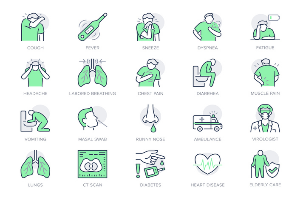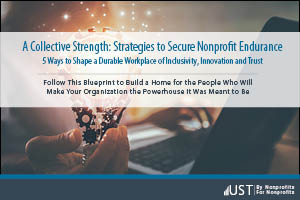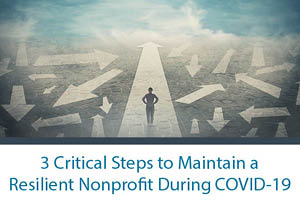
While remote work was on the rise even before the COVID-19 pandemic, most employees taking advantage of working from home still had some form of in-person relationship with their employer and fellow teammates. While it is still relatively rare for companies to hire employees to work remote from day one, we can see that this practice is changing. As stay-at-home orders continue in many states, more employers are having to rely on virtual recruitment and finding this will most likely become the new standard for all future recruiting.
From the perspective of talent acquisition and nonprofit business leaders, the most significant challenges being faced by organizations are resulting in changes that will continue after the pandemic. Some of these changes have resulted in unforeseen positive outcomes—creating a whole new outlook on what a day looks like in the office.
Here are four major changes revealed by the global pandemic and the lasting impact they will have on what the future of work looks like:
1) At-Home Working Environment: As organizations adapt to a remote workforce, the more willing they are to make a permanent change going forward. This will have a direct impact on the need for office space; many organizations are already considering downsizing the amount of office space needed, in turn saving money on overhead costs. Organizations should have a thoughtful plan in place prior to making their operation fully remote. By sharing remote working policies with staff and providing additional training to managers overseeing a remote team, you’ll ensure a much smoother transition.
2) Recruiting Becomes Virtual: As we’ve seen in recent months, talent acquisition teams have incorporated new recruitment practices—ranging from interviewing candidates over video, to giving job offers without meeting a candidate in person. Virtual recruiting has proven to have such success it will most likely carry over as a new process post pandemic.
3) Technology is Priority #1: Many organizations have come reliant on advanced technologies to help navigate this new remote working world. Talent acquisition teams have seen how technology has streamlined onboarding processes and how this is the more desired approach by both hiring managers and new employees. While incorporating a more technology-based recruitment system will require more training, it will increase privacy and security.
4) What Does Success Look Like Now: An organization can’t remain a float without their employees and now, more than ever, it’s important to listen and invest in your employees. This pandemic has forced organizations to make necessary investments in technology to ensure a functional working model. In turn creating significant benefits for both employees and their employers.
Now, the question everyone keeps asking is “what will happen when stay-at-home orders are lifted?” While there’s much talk about “getting back to normal,” some have come to terms with the notion that it isn’t most likely to happen. As organizations’ country-wide learn how to make remote work more functional, the possibilities of being able to leverage a larger pool of candidates, particularly those high-skilled hard-to-fill positions, is likely to become increasingly appealing. Talent acquisition and human resources leaders adapting to virtual interviews, offers and onboarding, has streamlined recruitment processes, while saving money. Nonprofit organizations will be able to use these recent changes to improve future recruiting outcomes.

Question: How can we cultivate a diverse workplace?
Answer: A diverse workplace with employees of differing age groups and experience can add to the richness and culture of any workplace. However, “diverse” and “diversity” can mean a host of different things, and unless company leaders agree on what kind of diversity they are seeking, creating cohesive diversity can be tricky. Here are some ideas for best practices to create and maintain a successful and diverse workforce:
Don’t forget to abide by all applicable local, state, and federal laws in regard to diversity and ensure all workplace policies are applied consistently and without discrimination.
Q&A provided by ThinkHR, powering the UST HR Workplace for nonprofit HR teams. Have HR questions? Sign your nonprofit up for a free 60-day trial today.

The ongoing COVID-19 pandemic has created new and unique challenges for employers and their employees. Group health plans and other employee benefit plans are one area of concern during these times. UST HR Workplace powered by ThinkHR has been on the front lines, supporting employers with HR and Benefits advice and compliance guidance through their online resources and on-demand advisors.
Here are some of the most-frequently asked questions received about COVID-19 and benefit plans:
Do all medical plans cover COVID-19 testing? Yes, the Families First Coronavirus Response Act (FFCRA) requires that all medical plans provide 100% coverage of COVID-19 testing. There are no deductibles, copays, or coinsurance. This federal mandate took effect March 18, 2020 and applies to insurance plans and employer self-funded plans, including grandfathered plans. It does not apply to retiree-only plans.
All testing-related services and services, such as consultative visits to doctors (including telehealth), emergency rooms and urgent care centers that lead to an order for testing, and the administration of tests, are covered. Preauthorization is not required and coverage is not limited to in-network providers.
Is treatment of COVID-19 also covered at 100%? It depends. The FFCRA mandate for 100% coverages applies only to services and supplies related to testing. Once diagnosed, however, coverage for any treatment of COVID-19 will depend on each medical plan’s terms and conditions, including any provisions for deductibles, copays, coinsurance, and use of network providers.
Additionally, insured plans are subject to state laws that may be broader than the new federal mandate. A number of states now require that medical insurers cover COVID-19 treatment at 100% (in addition to testing). Many carriers also have agreed to provide 100% coverage even if not required by law. For details, contact your carrier or check the America’s Health Insurance Plans (AHIP) website for the latest updates.
Is a high deductible health plan (HDHP) that waives the deductible for COVID-19 testing still compatible with a Health Savings Account (HSA)? What about coverage for treatment? HDHP must cover COVID-19 testing at 100% per the FFCRA mandate. HDHPs also may be amended to cover treatment of COVID-19 as a first-dollar benefit without deductibles. On March 11, 2020, the IRS announced that pre-deductible coverage of testing and treatment does not cause the plan to lose its status as an HSA-compatible HDHP and does not interfere with the covered person’s eligibility to make HSA contributions.
Many employees are working from home now instead of coming to the office. Can they continue using their Dependent Care FSAs for childcare expenses? Yes, employees can continue using their Dependent Care FSAs provided that the childcare is required for the employee to be able to work. For instance, employees working full time may need the same childcare whether working from home or the office. If, however, the employee or spouse can care for the child while the employee works, the expenses are not reimbursable.
Can employees change their Dependent Care FSA election due to the COVID-19 issues? The IRS rules for Dependent Care FSAs set forth a list of permissible election changes. (Ref: 26 CFR § 1.125-4.) Assuming the employer includes all IRS-permissible change events in its plan document, employees may start, stop, increase or decrease their Dependent Care FSA contribution on account of specific events. Examples of events that are likely to come up due to COVID-19 issues include:
Can employees change their commuter benefits since they are now working from home? Section 132(f) plan, often called pretax commuter benefits, allow employees to change their election, or start or stop contributing, for any reason. Generally, changes made by the middle of the month take effect the first of the next month, but employees will want to confirm their plan’s procedures with the administrator. Note that there is no use-or-lose provision for commuter benefits, so any unused balance now will be available for the employee’s use when they get back to commuting to work.
Many employees have been put on reduced hours or furloughed. Can the employer continue covering them on the group health plan? Many employers and workers are concerned about maintaining group health coverage when work hours are cut due to the current COVID-19 outbreak. Each employer’s case is different, so we suggest the following steps:
Q&A provided by ThinkHR, powering the UST HR Workplace for nonprofit HR teams. Have HR questions? Sign your nonprofit up for a free 60-day trial here.

Question: As we begin to return to work, if an employee is out of the office due to sickness, can we ask them about their symptoms?
Answer: Yes, but there’s a right way to do it and a wrong way to do it. In non-pandemic circumstances, employers shouldn’t ask about an employee’s symptoms, as that could be construed as a disability-related inquiry. Under the circumstances, however — and in line with an employer’s responsibility to provide a safe workplace — it is recommended that employers ask specifically about the symptoms of COVID-19.
Here is a suggested communication: “Thank you for staying home while sick. In the interest of keeping all employees as safe as possible, we’d like to know if you are having any of the symptoms of COVID-19. Are you experiencing a fever, cough, shortness of breath, chills, muscle pain, headache, sore throat, or a new loss of taste or smell?”
Remember that medical information must be kept confidential as required by the Americans with Disabilities Act (ADA). If the employee does reveal that they have symptoms of COVID-19, or has a confirmed case, the CDC recommends informing the employee’s co-workers of their possible exposure to COVID-19 in the workplace (but not naming the employee who has or might have it) and directing them to self-monitor for symptoms. Employers should also follow CDC guidance for cleaning and disinfecting.
Q&A provided by ThinkHR, powering the UST HR Workplace for nonprofit HR teams. Have HR questions? Sign your nonprofit up for a free 60-day trial here.

UST’s new blog series, “COVID-19 Nonprofit Stories,” illustrates how nonprofits and their employees have been coping with the unexpected challenges of the Coronavirus. Each blog spotlights one organization and the personal hurdles and workforce strategies they have encountered throughout this pandemic.
Our next story comes from another dedicated UST member—DARTS. Located in Minneapolis, DARTS provides personalized professional services to the aging demographic in the local Dakota County. By providing transportation and home services to their aging community, DARTS helps participants to lead more independent and fulfilling lives. Their services include such things as light housework, outdoor chores, home repair, caregiving resources, transportation and more.
Q: In general, how has your nonprofit been impacted by COVID-19?
A: DARTS provides services to help older adults stay engaged in the community and live in home of their choice. COVID-19 has caused older adults to isolate themselves and their caregivers are either isolated from their loved one or unable to have respite from them. The need for our services grew and we had to rapidly adapt to be able to provide them safely.
Q: What was the most immediate impact your organization faced during the onset of COVID-19?
A: DARTS provides bus rides for groups of older adults, as well as individuals. The group rides stopped immediately on March 13. We took our bus capacity to help fill a need that older adults were not able or willing to go out to food shelves to get groceries by partnering with area food shelves to help deliver those food supports.
Q: What do you see as the long-term impact COVID-19 will have on your organization?
A: How we gather as older adults will be affected for months to come and so we are becoming more nimble with technology to supplement in-person meetings and group gatherings. COVID-19 will help those with means to rely more on technology and it will make the gap larger between those who have resources and those who do not.
Q: How have you addressed employee mental health and wellness during this time?
A: We added intentional time during team meetings to talk about COVID related stress and social justice issues. We hold regular optional coffee breaks so that people can still connect, leaders are proactively reaching out to their team, we are allowing flexibility for those who can to work from home and we got brightly colored DARTS shirts for employees – a cheerful reminder as to how important they are to our community.”
Keep an eye out for future renditions of “COVID-19 Nonprofit Stories,” as we continue to gather insight from the nonprofit sector. In the meantime, check out our COVID-19 Resource Center for more nonprofit-specific content—including unemployment insights, workforce trends, employee wellness tips, COVID-19 FAQs and more!

Question: Can we reduce pay because of an economic slowdown due to COVID-19?
Answer: You can reduce an employee’s rate of pay based on business or economic slowdown, provided that this is not done retroactively. For instance, if you give employees notice that their pay will change on the 10th, and your payroll period runs from the 1st through the 15th, make sure that their next check still reflects the higher rate of pay for the first 9 days of the payroll period.
Nonexempt employees (those entitled to overtime) – A nonexempt employee’s new rate of pay must still meet the applicable federal, state, or local minimum wage. Employees must be given notice of the change to their rate of pay, and some states require advance notice.
Exempt employees (those not entitled to overtime) – An exempt employee’s new salary must still be at or above the federal or state minimum for exempt employees. The federal minimum salary is $684 per week. Several states have weekly minimums that are higher than that (California and New York, for instance, are in the $1,000 per week range). The minimum may not be prorated based on hours worked.
Exempt employee reclassification – If an exempt employee has so little work to do that it does not make sense to pay them the federal or state minimum (or you simply cannot afford to), they can be reclassified as nonexempt and be paid by the hour instead. This must not be done on a very short-term basis. Although there are no hard and fast rules about how long you can reclassify someone, it is recommended that you don’t change their classification unless you expect the slowdown to last for more than three weeks. Changing them back and forth frequently could cause you to lose their exemption retroactively and potentially owe years of overtime.
Employees with contracts or CBAs – If employees have employment contracts or are subject to collective-bargaining agreements (CBAs), you should consult with an attorney before making any changes to pay.
Q&A provided by ThinkHR, powering the UST HR Workplace for nonprofit HR teams. Have HR questions? Sign your nonprofit up for a free 30-day trial here.

UST releases a new eBook, focused on positive brand perception in today’s increasingly competitive job market.
Founded by nonprofits, for nonprofits, UST publishes an eBook that discusses the importance of ensuring you have a solid brand reputation and why. This insightful eBook uncovers strategies that nonprofit employers can utilize to attract employees that fit their organization’s culture, mission, and values—and keep them.
Available now for download, UST’s eBook explores 5 key strategies that can help strengthen your organization’s culture through inclusivity, innovation and trust.
You’ll also discover:
Don’t miss your opportunity to download your complimentary copy of “A Collective Strength: Strategies to Secure Nonprofit Endurance” to discover how to attract better talent and promote a diverse and inclusive workplace.

Question: Some of our employees have said they don’t feel safe returning to work. Can we just permanently replace them?
Answer: We recommend extreme caution when deciding to replace an employee who refuses to work because of concerns about COVID-19. Generally, employees do not have a right to refuse to work based only on a generalized fear of becoming ill if their fear is not based on objective evidence of possible exposure. However, under the current circumstances, where COVID-19 continues to be a threat across the country, we think it would be difficult to show that employees have no reason to fear coming in to work, particularly but not exclusively in a location with a shelter-in-place rule. Returning employees may also have certain rights under state and federal law. Here are few things to keep in mind:
Check state and local law to see if additional protections may apply.
Instead of replacing employees who express fear at this time, we recommend that you consider methods to encourage employees to come to work and to help put their minds at ease. Consider emphasizing all of the safety methods you have put in place (such as scheduled handwashing, frequent disinfection of surfaces, social distancing rules, reduced customer capacity, staggered shifts, or more extreme measures if warranted by your industry). We recommend relying on the Centers for Disease Control and Prevention (CDC) and local health department guidance for establishing safe working conditions at this time. You might also consider offering premium pay (a.k.a. hazard pay) or additional paid time off for use in the future to employees who must come to work.
Q&A provided by ThinkHR, powering the UST HR Workplace for nonprofit HR teams. Have HR questions? Sign your nonprofit up for a free 60-day trial today.

As nonprofit organizations prepare to return to business as usual, there are quite a few new safety protocols being put in place to ensure that employees return to a safe work environment. The Center for Disease Control – CDC continues to release updated guidelines for employers to help prevent and slow the spread of COVID-19 in the workplace. When making decisions around business operations, two main components should be factored in: (1) the level of disease transmission in your community and (2) how prepared your business is to protect both your employees and customers.
Employers are encouraged to coordinate with their state and local health officials to acquire timely and accurate information to provide updates to employees as needed. If your nonprofit’s business operations were put on hold, or are gearing up for workforce re-entry, this is an opportunity to update your COVID-19 preparedness, response and control plans.
When making the appropriate updates to your organization’s COVID-19 plans, the following items should be included:
Be sure to take the time to communicate with your employees of any changes and ask for their input—their questions and concerns can ensure all your bases are covered when creating the COVID-19 plan for your organization. Educating our employees on the severity of taking the necessary precautions to keep themselves and others safe is vital. To protect themselves while at work and at home, new policies and procedures related to illness, cleaning and disinfecting should be followed.
To ensure a safe workplace environment, employers should advise their employees of the following:
While there is much more to learn about the severity and characteristics of this virus, as a nonprofit employer, you can do your part to follow important guidelines to create a safe and healthy working environment for your dedicated employees.

Are you still trying to figure out how to navigate the uncertainty of COVID-19 and its impact on your nonprofit and its employees? When you download UST’s new employer guide, 3 Critical Steps to Maintain a Resilient Nonprofit During COVID-19, you’ll discover helpful tips on maintaining your nonprofits operations during the current pandemic and beyond.
This short employer guide shares valuable insights and key strategies for securing your brand during times of crisis, including:
This guide will not only enable you to stay on top of strategy development, but also equip you with the tools you need to help your employees feel safe. Download your FREE copy today!

UST maintains a secure site. This means that information we obtain from you in the process of enrolling is protected and cannot be viewed by others. Information about your agency is provided to our various service providers once you enroll in UST for the purpose of providing you with the best possible service. Your information will never be sold or rented to other entities that are not affiliated with UST. Agencies that are actively enrolled in UST are listed for review by other agencies, UST’s sponsors and potential participants, but no information specific to your agency can be reviewed by anyone not affiliated with UST and not otherwise engaged in providing services to you except as required by law or valid legal process.
Your use of this site and the provision of basic information constitute your consent for UST to use the information supplied.
UST may collect generic information about overall website traffic, and use other analytical information and tools to help us improve our website and provide the best possible information and service. As you browse UST’s website, cookies may also be placed on your computer so that we can better understand what information our visitors are most interested in, and to help direct you to other relevant information. These cookies do not collect personal information such as your name, email, postal address or phone number. To opt out of some of these cookies, click here. If you are a Twitter user, and prefer not to have Twitter ad content tailored to you, learn more here.
Further, our website may contain links to other sites. Anytime you connect to another website, their respective privacy policy will apply and UST is not responsible for the privacy practices of others.
This Privacy Policy and the Terms of Use for our site is subject to change.
UST maintains a secure site. This means that information we obtain from you in the process of enrolling is protected and cannot be viewed by others. Information about your agency is provided to our various service providers once you enroll in UST for the purpose of providing you with the best possible service. Your information will never be sold or rented to other entities that are not affiliated with UST. Agencies that are actively enrolled in UST are listed for review by other agencies, UST’s sponsors and potential participants, but no information specific to your agency can be reviewed by anyone not affiliated with UST and not otherwise engaged in providing services to you except as required by law or valid legal process.
Your use of this site and the provision of basic information constitute your consent for UST to use the information supplied.
UST may collect generic information about overall website traffic, and use other analytical information and tools to help us improve our website and provide the best possible information and service. As you browse UST’s website, cookies may also be placed on your computer so that we can better understand what information our visitors are most interested in, and to help direct you to other relevant information. These cookies do not collect personal information such as your name, email, postal address or phone number. To opt out of some of these cookies, click here. If you are a Twitter user, and prefer not to have Twitter ad content tailored to you, learn more here.
Further, our website may contain links to other sites. Anytime you connect to another website, their respective privacy policy will apply and UST is not responsible for the privacy practices of others.
This Privacy Policy and the Terms of Use for our site is subject to change.